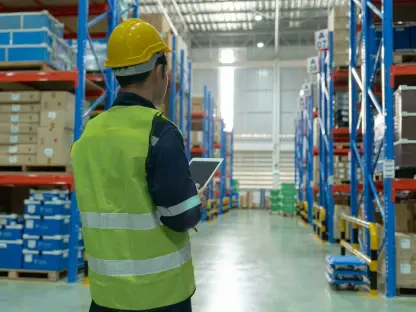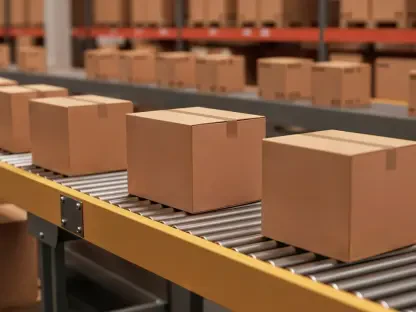The significant increase in the sales of mobile robots within the intralogistics sector in 2024 highlights the evolving landscape of automation. According to the International Federation of Robotics (IFR) and its annual report, “World Robotics – Service Robots,” almost 113,000 robots were sold globally for transport and logistics tasks last year. Remarkably, nearly 80,300 of these were mobile robots specifically designed for material transport, underscoring their growing importance in production supply, warehouse operations, and loading/unloading tasks.
Regional Adoption and Market Share
Dominance of the Asia-Pacific Region
The Asia-Pacific region has emerged as the leader in adopting mobile robots, driving approximately 83% of global sales in this segment. This trend can be attributed to the high demand for automation solutions in densely populated and industrially advanced nations such as China, Japan, and South Korea. These countries have increasingly integrated mobile robots into their logistics and transport operations, fostering higher efficiency and productivity. The impressive adoption rate in this region reflects a broader trend toward technological advancement and economic growth, with automation playing a pivotal role in streamlining operations.
In contrast, Europe, the Middle East, and North Africa collectively comprised about 10% of the market share. While these regions embrace automation technologies, their adoption pace is relatively slower compared to the Asia-Pacific. Factors such as regulatory environments, market maturity, and varying degrees of technological infrastructure contribute to this disparity. Additionally, North and South America accounted for 7% of the global market. The Americas are gradually embracing automation, albeit at a pace moderated by economic conditions and sector-specific needs. The overall market distribution highlights an ongoing shift toward efficient and scalable robot-based solutions worldwide, emphasizing the Asia-Pacific region as the principal driver of growth.
Factors Influencing Adoption Rates
Several factors contribute to the differing adoption rates observed across various regions. In the Asia-Pacific region, government support and significant investments in research and development have catalyzed the widespread adoption of mobile robots. Policies that encourage innovation, coupled with substantial funding for technological advancements, create a conducive environment for the proliferation of automation technologies. Moreover, the region’s competitive manufacturing landscape necessitates high efficiency and cost-effectiveness, further driving the demand for mobile robots in intralogistics.
Conversely, in Europe, the Middle East, and North Africa, regulatory frameworks and economic conditions present unique challenges and opportunities. European countries, in particular, prioritize compliance with stringent safety and operational standards, which can slow the adoption process but ultimately ensure higher-quality implementations. The regulatory landscapes in the Middle East and North Africa vary, influencing the pace at which automation technologies are incorporated into logistics operations. In the Americas, economic volatility and specific industry requirements shape the adoption trajectory, with particular emphasis on sectors like e-commerce and manufacturing, where efficiency gains are critical.
Insights from Industry Leaders
Expert Opinions on the Growth of Mobile Robots
Wolfgang Hillinger, chairman of the Mobile Robots Division of the VDMA Materials Handling and Intralogistics Association, and Sascha Schmel, the association’s managing director, have highlighted the significant impact and importance of mobile robots in modern logistics operations. The association, representing around 50 manufacturers, plays an essential role in offering expertise in technical regulations and standardization, ensuring that deployed robots meet industry standards and operate efficiently. The VDMA’s contributions include a wealth of market data, which informs stakeholders about current trends and future opportunities within the sector.
Hillinger and Schmel emphasized that mobile robots are increasingly crucial in addressing the dynamic requirements of contemporary supply chains. As logistics operations become more complex and demand rapid adaptability, autonomous mobile robots provide flexible solutions for various tasks, from inventory management to coordinating production lines. By streamlining these processes, businesses can achieve higher operational efficiency and meet the growing demands of consumers with greater precision.
Comprehensive Market Data and Analysis
The IFR’s “World Robotics – Service Robots” report provides a detailed analysis of the global market for service robots, with a particular focus on the intralogistics segment. This annual report, derived from an in-depth evaluation of 298 companies, offers a comprehensive overview of current market conditions, including sales trends, regional adoption rates, and future growth projections. The report also includes expert interviews and collaborates with entities like Fraunhofer IPA to deliver a robust market assessment, ensuring that the provided insights are both accurate and actionable.
The report reveals a broader context wherein professional service robots experienced a 30% increase in global sales in 2023, totaling over 205,000 units. This growth is predominantly driven by the transportation and logistics sector, which accounted for 55% of these sales. Other segments such as hospitality (26%), agriculture (10%), professional cleaning (6%), and medicine and healthcare (3%) also saw notable increases. This data underscores a burgeoning interest in implementing robotic solutions across various industries, with intralogistics leading the charge in the widespread adoption of automation technologies.
Future Prospects and Market Dynamics
Technological Advancements and Market Growth
The rapid surge in mobile robot sales for intralogistics is a clear indicator of the increasing importance of automation in the logistics and transportation sectors. The IFR’s comprehensive research points to a thriving market environment, where advancements in automation technologies drive robust growth. Mobile robots, integral to modern supply chain operations, facilitate tasks such as production supply, warehouse management, and the efficient loading and unloading of goods, streamlining processes and enhancing productivity.
Analyzing the market dynamics, it is evident that the integration of mobile robots is not a fleeting trend but a significant shift toward future-forward logistics solutions. The steady growth observed in both the intralogistics segment and the broader service robotics market underscores the pivotal role automation plays in transforming industries. Companies increasingly recognize that adopting these technologies is imperative for staying competitive and meeting the demands of a rapidly evolving market landscape.
Challenges and Opportunities Ahead
The substantial surge in mobile robot sales within the intralogistics sector in 2024 marks a significant shift in automation trends. As reported by the International Federation of Robotics (IFR) in their annual publication “World Robotics – Service Robots,” global sales for robots performing transport and logistics functions hit almost 113,000 units last year. Of these, an impressive 80,300 were mobile robots tailored for material transport tasks, highlighting their burgeoning role in production supply chains, warehouse activities, and the processes of loading and unloading.
This growth demonstrates the increasing reliance on robotic technology to enhance efficiency and streamline operations in various industries. Mobile robots have become indispensable for improving productivity, reducing human error, and ensuring the smooth movement of goods within facilities. Companies are recognizing the value of automation to stay competitive and meet rising demand. As mobile robots become more advanced, their adoption is likely to continue expanding, transforming the landscape of modern logistics and warehousing further.









